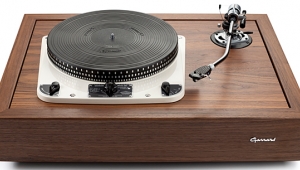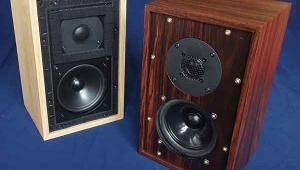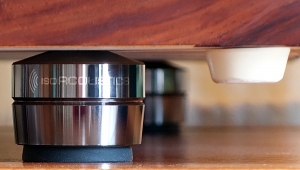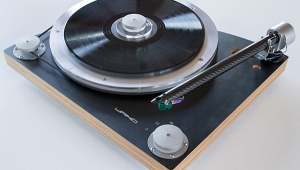| Columns Retired Columns & Blogs |
Listening #57
A moment of silence, please, for the mouse in my shed: I've had a trap there for weeks, baited with peanut butter—I should have just waited for the food poisoning to do its work—and the poor little bastard finally found it.
Footnote 1: Low-frequency saturation, that other audio-transformer bugaboo, is not really an issue here.
It was a bad end, but not as bad as starvation, or being swallowed by a snake, or torn apart by a house cat. He might also have died from a severe blow to the head, had the glass jar I threw at him three Saturdays ago found its target instead of the wall behind him. (That dumb stunt was made even more exquisitely stupid by the fact that the jar still had a little gasoline in it, from when I tried to fix the snowblower last March.) Nor was indifference an option: No one loves small, frightened woodland animals more than I do, but mice carry hantavirus, and that's nothing to screw around with. Besides, this mouse had chewed my MerleFest hat, and burrowed into the seat of my lawn tractor.
So I bought an old-fashioned Victor mousetrap, the kind where the V in the logo is also the pointy nose of a stylized mouse. If you've ever watched cartoons on a Saturday morning, you know how the thing works: A spring-loaded wicket, mounted to a scrap of wood, is pulled back and held tenuously in place with a stiff length of wire, itself hooked against a wobbly metal plate. When a mouse tries to steal a piece of cheese from that plate—never mind that cheese is not normally a part of a mouse's diet—the plate moves just enough to dislodge the wire holding the tightly sprung wicket, which snaps back to its resting place, dispatching the mouse to his. The end.
During the century and a half since it was invented, the Victor Pest Control company has altered the basic mousetrap in only two ways: They have switched to sustainable-yield wood products—good for them!—and have begun replacing their metal bait plates with ones molded from yellow plastic, with dimples that suggest the holes in Swiss cheese. Otherwise, the thing is exactly the same.
That's not to say that alternatives haven't appeared. Today's consumer can buy glue traps, plastic snap-traps, electric traps, live traps for single mice, live traps for multiple mice (think: Spartacus), poison baits, and ultrasonic mouse repellents that look uncannily like the products of a certain well-loathed Framingham audio corporation. Do-it-yourselfers can even browse the Internet for various mousetrap plans, including one award-winning (seriously) design that's based on a two-liter Pepsi bottle.
All the new ones suck. The end.
Electrical loads, mechanical sins
I feel the same way about moving-coil step-up devices that aren't transformers: I don't like them.
The 47 Laboratory Phonocube sounded wonderful with the Miyabi 47 phono cartridge, for which it was specifically designed. The Linn Linto sounded good with almost every cartridge I tried—very good with some of them. And I'm sure there are one or two other active phono preamps that are similarly recommendable. But in my experience, a properly chosen trannie lets the music breathe in and out more realistically, and allows for a heightened sense of musical drama, compared with an active pre-preamp. Low-output moving-coil cartridges have more soul when they're used with a step-up transformer.

And I'll tell you what: Although I've heard more than a few egregiously bad active devices in my day, even the cheapest trannies I've tried have been decent and recommendable. I have yet to hear a really bad one.
The transformer approach looks better on paper, too. During the age when stereo LPs were the source of choice, domestic preamps evolved to a general performance level from which they've changed remarkably little, even in the quarter-century since the advent of the compact disc: Of the full-function products that remain, most can be driven by the output voltage of a typical moving-magnet phono cartridge—say, from 3.5 to 6mV—with negligible noise. The average moving-coil cartridge can't perform the same trick, but because at this end of the system we're looking for voltage gain (as opposed to power), there's virtually no penalty in trading away some of the MC cartridge's rather abundant current for higher voltage. And that's precisely what a step-up transformer can do.
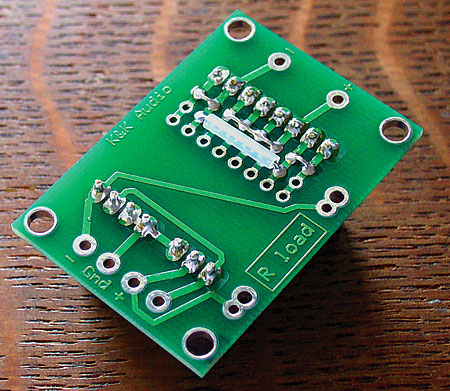
If it's well designed—which is to say, if it resists hum, and if it doesn't audibly, egregiously shift the phase of the audio signal (footnote 1)—an MC step-up transformer gives you voltage gain for free, notwithstanding a slight departure from perfect efficiency, owing to insertion losses. And if it's well selected, a step-up transformer does even more: It presents an MC cartridge with an appropriate load impedance, which not only allows for accurate voltage transfer, from the lowest frequencies to the highest, but also presents the conditions necessary for electrical self-damping, thought by many (including me) to absolve such mechanical sins as ringing and mistracking.
If transformer design and manufacture are a black art, transformer selection is more straightforward. The key is choosing a trannie that has both the right amount of gain and the right impedance characteristics for the cartridge being used. Those two qualities usually go together, but the latter can be more than a bit confusing.
First, a reminder: All moving-coil cartridges exhibit a certain DC resistance, expressed in ohms and directly related to the number of turns of wire in each coil—which itself relates to the cartridge's voltage output. But DC resistance isn't the same as AC impedance, which is derived from a complex combination of resistance (which can be measured) and frequency-dependent reactance (which, under most circumstances, can only be predicted). As an audio-bandwidth device, your MC cartridge has its own characteristic source impedance—but, again, that characteristic can't be measured in isolation, and can only be modeled, under conditions that include a typical load.
Footnote 1: Low-frequency saturation, that other audio-transformer bugaboo, is not really an issue here.
- Log in or register to post comments






